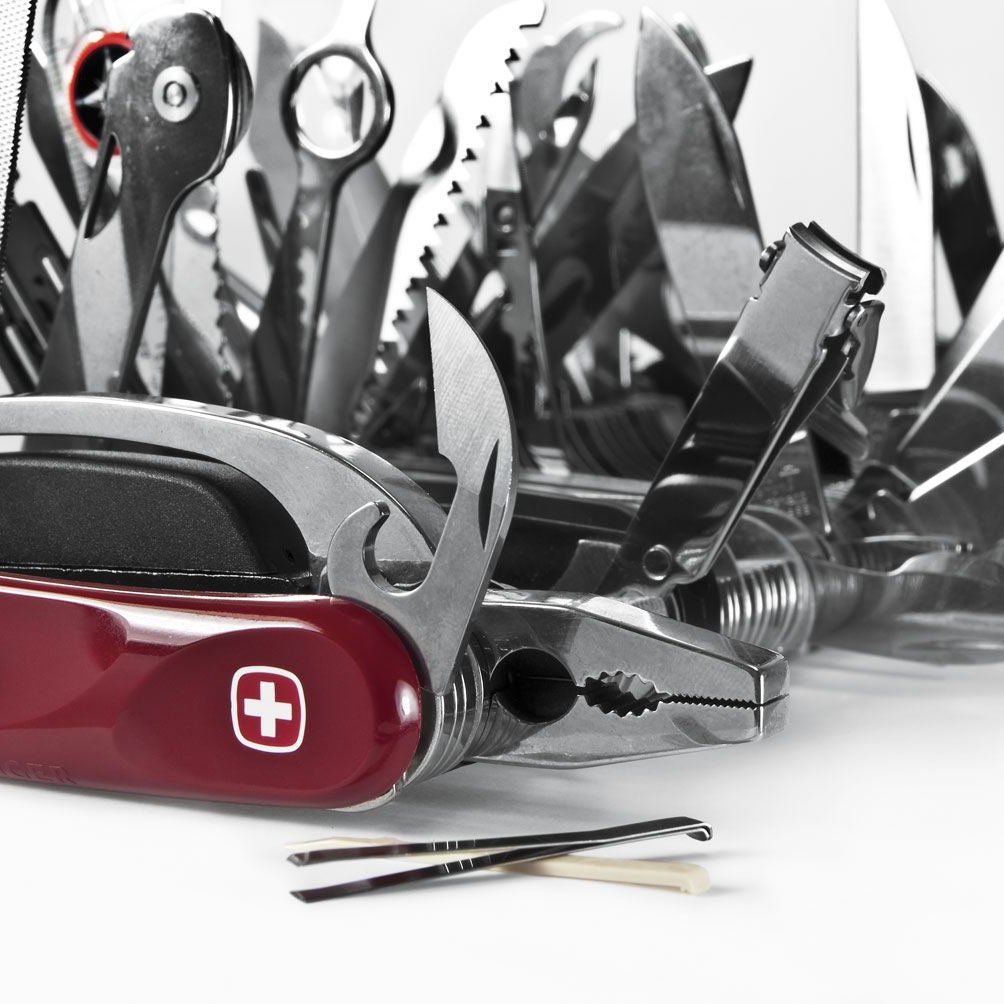A good pocketknife creates a foundation of preparedness: with one, you can respond to everything from small, everyday tasks—slicing open boxes, cutting a tag—to big emergencies—rescuing yourself or someone else from a car accident. I’ve researched and tested pocketknives for over 30 years, across six continents, and on tasks ranging from the mundane to the genuinely lifesaving. All of my research and testing has led me to the very best pocketknives—and everything you need to know to find the perfect one for you.
Part of the fun here is using different knives, and developing your tastes and preferences over time. When I was ten, I thought Swiss Army Knives were the pinnacle of sophistication. At 41, I’ve learned I prefer a high quality folder. Your journey will be different, because it’s your own.
Benchmade Tagged Out ($200)
The Best Pocketknife
The most important quality of any blade is its sharpness. It’s the primary determining factor in a knife’s performance and what makes a knife safe to use. A sharp knife requires less force, and therefore reduces the odds of your hand slipping down the handle, onto the sharp edge or accidentally pushing or pulling it through whatever substance you’re cutting.
Pretty much any knife that isn’t the result of an impulse purchase at a gas station is going to arrive in your pocket with an adequately sharp blade. But every time you use your knife, you’ll incrementally dull its edge. So factors to keep in mind are how long a knife is able to retain its edge and how much work it’s going to take to keep that knife sharp.
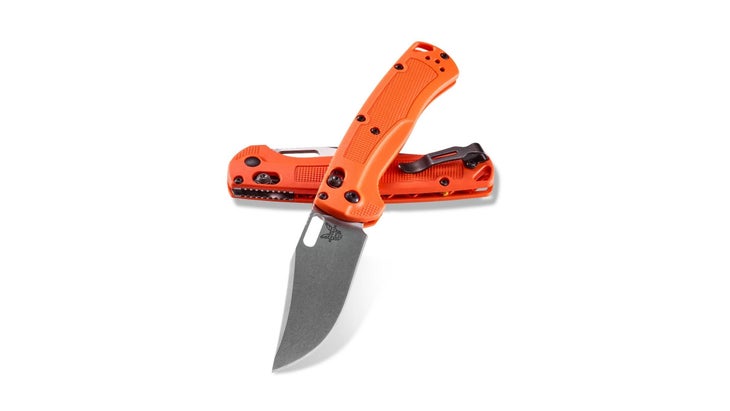
The absolute sharpest blade I’ve ever tried, and the one that stayed sharp for the longest time, comes from Benchmade’s Select Edge technology. Look at the edge on most knives under a microscope and you’ll see a jagged line, not a straight one. Those bumps and grooves introduce weakness, which allows wear. Select Edge controls the placement of individual carbide molecules in its steel, eliminating that microscopic jaggedness. Benchmade is then able to take advantage of that added strength to offer a finer edge angle. The only folding pocketknife currently available with Select Edge is the $200 Tagged Out.
My only complaint: Select Edge’s unique angle and extraordinary hardness makes it difficult to sharpen the knife yourself. You’ll need to ship your Select Edge knife to Benchmade to bring it back from dull.
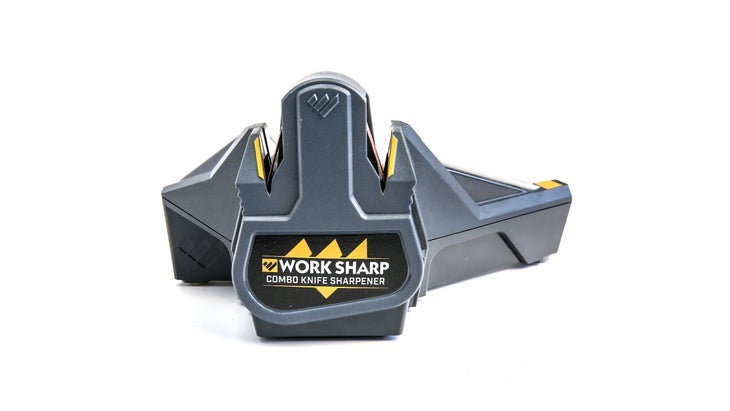
Work Sharp Combo ($50)
The Best Knife Sharpener
The easiest way to keep a pocketknife sharp is to buy one made from steel you can sharpen yourself. And the most convenient knife sharpener I’ve ever found is the $50 Work Sharp Combo Knife Sharpener. Like any powered belt sharpener, you’ll need to be careful not to round a blade’s tip or overheat its steel, but once you’ve read the instructions, this thing is just downright easy to use. Give your knife a few swipes on each side regularly, and it will never go dull.
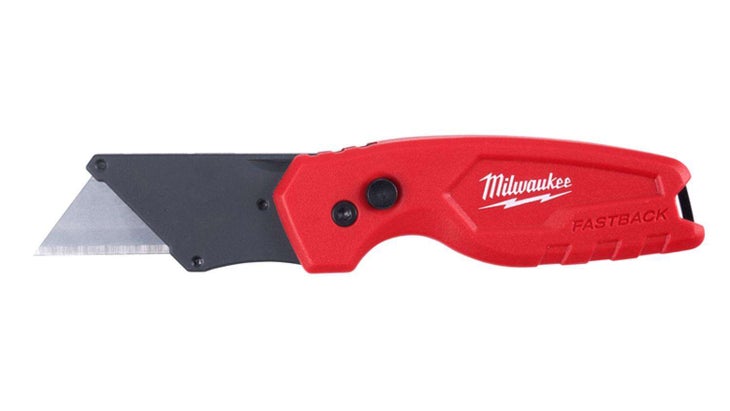
Milwaukee Fastback ($15)
Best Replaceable Blade Knife
Another way to ensure you always have a sharp blade handy is to go with a replaceable blade knife. This may be the best option for people using their knives for daily work, as pausing to sharpen a blade multiple times throughout a day is anything but efficient. The downsides are that thin, replaceable blades break easily if bent or twisted, and that carrying plenty of replacement blades can get annoying. If you go this route, fans love the $15 Milwaukee Fastback for its ease of opening, well-placed pocket clip, and its ability to store up to five extra blades inside its handle.
CRKT LCK+ ($44)
Best to Carry
The second most important quality for a knife to have is to be easy to carry. Blade size, handle shape, and pocket clip arrangement are all determining factors of how well a knife carries.
The longer a knife blade, the larger objects it can cut. Blades that are thicker may be stronger, and ones that are broader may offer better slicing performance. But a lot of blade shape and size comes down to looks and feel. Some knife users simply prefer a the sturdy looks and heft provided by longer, fatter, broader blade.
The tradeoff to size is, well, size. A good compromise between utility and pocketability comes with a blade length of about three to four inches.
While the dimensions of a pocketknife’s handle are largely determined by the blade that pivots into it, the shape of its edges and its thickness are also determined by its design. A handle with smooth, rounded edges, which is as slim as possible, will more easily fit into more pockets. But you also want a handle that is comfortable to hold. The size of your hand, and the amount of work you intend to perform with your knife will inform what size and shape of handle is right for you.
A clip ensures pocketknives ride securely. While this might seem like a simple feature, slight variances in clip location can actually make a huge difference. The best clips are those that conceal the entire body of the knife under the lip of your pocket—not for the purpose of stealthiness, but simply for security. A knife handle that protrudes above the level of your pocket may catch on things, press into your hip when you sit down, and provide less security. If your knife catches on something, and falls out of your pocket, or if you have to take your knife out of your pocket to find comfort, then that knife may not be with you when you need it.

The $44 CRKT LCK+ is around the size of a Sharpie, and it provides a perfect deep-carry pocket clip that orients the blade tip up, and to the rear of a right-hand pocket. While the handle is slim, it’s long enough to fill my size-11 hands, and provides ample traction.
Opinel No. 8 ($18)
Best Budget Pocketknife
Compared to a fixed blade—where the blade and handle are one unit—folding knives add a potential point of failure. This is what makes them easy to carry, since they fit into a pocket, typically without the need for a sheath, but it also introduces an element of danger. Should a pocketknife’s blade fold onto your hand or fingers during use, it’ll hurt. To prevent accidents, virtually all folding pocketknives include some sort of blade retention feature.
The simplest form of blade retention comes from friction. The prototypical example here is the Swiss Army Knife, which simply pinches its blade tightly inside its frame, making it hard to move in either direction. The benefit there is the low price, the downside is it doesn’t do much to keep your blade open.

A better choice is some sort of mechanical device that physically prevents the blade from opening. The simplest, easiest one is the rotating collar on an Opinel. By rotating over the channel the blade folds into, it prevents that knife’s blade from closing on your hand. But deploying the Opinel’s blade requires two additional steps—first twisting the collar closed when you open the blade, then doing the same in reverse before you can close it.
The best retention mechanisms deploy automatically, any time the blade is opened, and also work to keep the blade safely inside the handle as the knife rides in your pocket. Different brands achieve this in many different ways. Some are complicated, requiring buttons, springs, and other small parts that might easily fail. A stronger, simpler, but more expensive method is to separate a portion of the knife’s frame, then bend that inwards so it wants to spring behind the blade as it opens. This can be done using either a metal liner that rides inside some other handle material, or with the entire, unified frame of the knife.
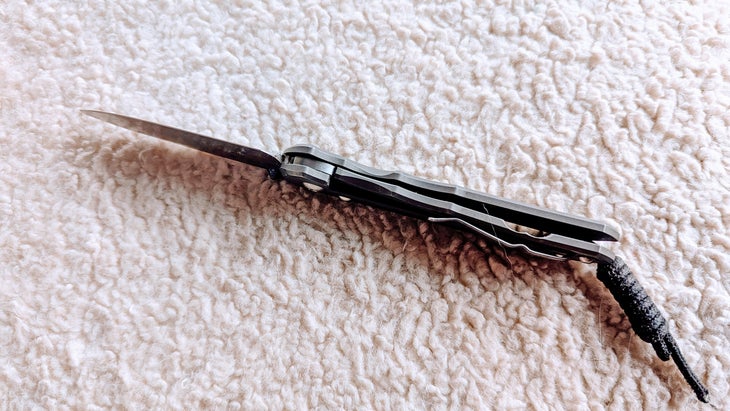
Sebenza 31 ($450)
Best Splurge Pocketknife
South African knife designer Chris Reeve invented the frame lock in the late-1980s. His $450 Sebenza 31 continues to be one of the strongest, highest quality pocketknives out there. The Sebenza’s handles are simply two slabs of titanium bolted together. Half of one side is separated and tensioned, so it folds to block the entire width of the blade when open.
Flaws But Not Deal Breakers
If a knife is sharp, easy to carry, and features a secure, convenient locking mechanism, it’ll be a good knife. But beyond those factors, there are a bunch of other variables to consider.
Blade Shape and Grind
A knife blade has a length, thickness, width, and both two and three-dimensional shapes. A lot of this is simply aesthetic in nature, which is to say: pick one you think looks cool. There are some performance variables—a slim knife with a high grind will slice better—but the differences are very small. When in doubt, simply look for a shape that’s not too zany, and a blade that’s not too thick, which offers a high or totally flat grind. That’ll be good at everything.
Opening Mechanisms
The nail knick on a Swiss Army Knife or old pen knife generally takes two hands to open, and a good fingernail. A thumb stud might provide more purchase and allow the use of a single hand, but it can snag on pocket linings. A spring-operated assisted opening feature can make a blade fast to deploy, but it adds complication and potential for failure. A lever built into the back of the blade might make a knife easy to flip open and form a finger guard when deployed, but it can also snag. There are pluses and minuses to everything; try out new knives to see what you like.
Steels
As you move up in price with knives, you’ll see the types of steel used to construct their blades listed as selling points. There are far too many varieties of steel to mention here. Understand that any claim like “surgical steel” is total bullshit, and instead look for brand and alphanumerical name, like CPM S35V or Böhler M390. Google will then direct you to descriptions of that steel’s merits. In addition to the type of steel, some knife makers and steel producers also apply unique heat treatments that can add additional performance to blades.
What About Multitools?
While many multitools incorporate a knife blade into their toolset, the blade is typically of bargain basement quality and can be complicated to access. While a multitool may technically be pocketable, and may even include a pocket clip, they’re almost always much bulkier, which makes them less convenient to carry and less comfortable to use. If it’s not with you, you won’t be able to use it.
But a good multitool does make a good accompaniment to a good pocketknife, if you can carry both. If not, stick with the knife, which you’ll use more often.

What’s in My Pocket?
When I got home from the airport late last night, the first thing I did was grab a knife out of my knife drawer and stick it in my pocket. That happened to be a $190 Spyderco Paramilitary 2 with a CPM CruWear blade and brown micarta handle.
With a 3.5-inch flat-ground, drop-point blade, the Paramilitary 2 is just the right size for pocket carry in a typical pair of jeans. It features a strong liner lock design that inserts a portion of the frame between the back of the blade and one of the bolts that holds the thing together, so there’s no way the blade could ever accidentally close.
This particular version is made special by both its blade steel, and the handle material. CPM Cruwear is an exceptionally hard-wearing tool steel that’s capable of holding an edge for a long time, but nevertheless requires a little special attention due to its high carbon content. I don’t mind rubbing a little Ballistol on the blade every time I clean it, but it would easily tarnish and develop surface corrosion without that care. On top of the steel frame liners, Spyderco has fitted a handle made from linen micarta. That material sets fibers into a resin, producing a comfortable surface that’s almost soft to the touch, and which remains tractive when wet. Both that steel and the handle will develop a unique patina over time.
I don’t like Spyderco’s pocket clips, so I will replace this one with a deeper carry option in the near future.
Accompanying the blade, I also carry a small $35 Leatherman Style PS on my keychain. It’s TSA compliant, so it travels with me and provides some capabilities the knife cannot. I use it less than the knife, so choosing a multitool that’s as small as possible makes sense for my needs.
On Sunday, I used the knife to field dress a deer. Two nights ago, while staying in a hotel, I used the tweezers in the multitool to remove a splinter. I was prepared for that and more, all thanks to the content of a single pants pocket. You can be too.

